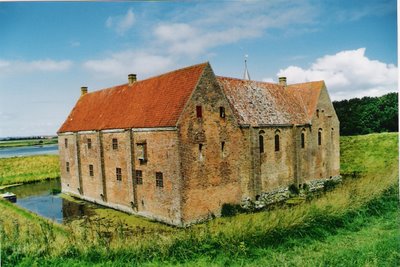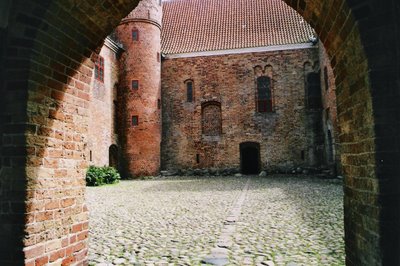Are you going to Scarborough Fair?
Parsley, sage, rosemary, and thyme
Remember me to one who lives there
She once was a true love of mine
Parsley, sage, rosemary, and thyme
Remember me to one who lives there
She once was a true love of mine

Spice Herb
Petroselinum crispum
Parsley Petroselinum crispum is a species of Petroselinum in
the family Apiaceae, native to the central Mediterranean region and
naturalized elsewhere in Europe - it is widely cultivated as a herb, a
spice and a vegetable. The Latin name
Petroselinum means "that which grows upon a cliff". Parsley was in
ancient time shipped from Egypt to Greece and brought on to the Romans
who brought it with them to Middle Europe. Today it is cultivated all
over the world. Two main groups of
parsley used as herbs are curly leaf and the Italian flat leaf group
(Petroselinum crispum neapolitanum). The flat leaf group
more closely resembles the natural wild species.
In Denmark parsley is not a part of our wild flora but it is often seen feral from cultivating. Parsley is the spice herb most commonly used in Scandinavia.
In Denmark parsley is not a part of our wild flora but it is often seen feral from cultivating. Parsley is the spice herb most commonly used in Scandinavia.
 |
| Devil, Fanefjord, Møn /GB |
The seeds can be sowed directly in the earth or in pots in spring. Some give the advice to put the seeds in lukewarm water for 24 hours before sowing. The seeds have a bitter taste and are not suited for food. Parsley does not require the big care, but the rows with the new plants must be kept free of weed and the earth must be loose If the parsley stands in a very sunny spot it is necessary to water them regularly. Parsley should never be cultivated in the same place two years in a row.
You
can start to pluck the leaves as soon as the plant has achieved a fair
size. If the plants get enough water they will grow well. Parsley
tolerates low temperatures well and you will be able to pluck fresh
parsley until Christmas. The plant can overwinter but likes to be covered with
sprigs of spruce in the cold period, then you'll have the old
plant to pluck in early spring until it blooms and withers, while the newly
sowed parsley grows up and is ready for use in early summer.
Before the cold weather arrives in the winter season the plant can be
moved to a pot and brought inside. When the leaves are plucked
regularly the plant will remain fine and bushy.
Kitchen:
 A Greek proverb "to be in the parsley" means that you
have just started something.
A Greek proverb "to be in the parsley" means that you
have just started something. Parsley can be used as aroma and flavor enhancer in various dishes like vegetables, sauces, soups, stew and fish. Parsley reconciles all kinds of flavor so they go up in an artitstic unit. Parsley leaves and root should be used while fresh, they should not be kept more than two days before use. The leaves loose quickly the C-vitamin contents which is also reduced by cooking
Fines herbes is traditionally: estragon, parsley, chervil, chives.
Bouquet of herbs for bouillabaise: fennel, lovage, 1 stalk hyssop, parsley, thyme, basil, sage, a bay leaf, and a little whole allspice.
Parsley can be frozen or dried, when it is dried it is easy to crush in the hand. When drying parsley the leaves easily grow yellow if the drying proces is too long. It is better to dry the leaves in an open oven by 35 degrees The dried leaves are kept in a glass jar.
After a big meal a cup of parsley tea or a little parsley in vegetable juice is good. If you chew parsley after meals with garlic or onion you'll get a fresh breath .Fresh parsley is also suited for freezing. Put fx finely chopped parsley in the icecube tray and it is then ready to put into the sauce.
Poisonous:
The difference between parsley and hemlock: crushed hemlock has a very unpleasant odor resembling cat piss.
History:
 Parsley is
described in a Greek herbal in the 3rd century B.C. In the Middle Ages
parsley was often called the Devil's herb. People were convinced it
meant death if the plant was moved from its place. The ancient Greeks considered parsley a bad plant and as a symbol of death and therefore it was used in funeral rituals.
Parsley is
described in a Greek herbal in the 3rd century B.C. In the Middle Ages
parsley was often called the Devil's herb. People were convinced it
meant death if the plant was moved from its place. The ancient Greeks considered parsley a bad plant and as a symbol of death and therefore it was used in funeral rituals.
In Rome however parsley was very popular. A garland of parsley was said to stop drunkenness - and the Romans had already discovered its good qualities in the kitchen too.
The Romans gave the gladiators parsley before they had to go to fight in the arena - it had almost the same effect as the spinach had on Pop-eye whose arm muscles grew to the double !
 Parsley is
described in a Greek herbal in the 3rd century B.C. In the Middle Ages
parsley was often called the Devil's herb. People were convinced it
meant death if the plant was moved from its place. The ancient Greeks considered parsley a bad plant and as a symbol of death and therefore it was used in funeral rituals.
Parsley is
described in a Greek herbal in the 3rd century B.C. In the Middle Ages
parsley was often called the Devil's herb. People were convinced it
meant death if the plant was moved from its place. The ancient Greeks considered parsley a bad plant and as a symbol of death and therefore it was used in funeral rituals.In Rome however parsley was very popular. A garland of parsley was said to stop drunkenness - and the Romans had already discovered its good qualities in the kitchen too.
In Greek mythology the hero Archemorus took part in the Istmian Games -
religious festivals which were celebrated at the island Isthmos in
honor of the god Poseidon. Archemorus was wounded and when the drops of
blood fell to the ground the parsley grew up and a victory garland was
made for him from the herb. The Greeks and Romans decorated themselves
with festival garlands where bunches of parsley were braided together
with other plants and flowers.
King Mithridates, king of Pontos, was a fine botanist who knew all
poisonous plants. He murdered his own family with poison, but he was
afraid of being poisoned himself, and he invented an effective antidote:
thyme, coriander, rue and many other spice herbs and lots of parsley.
Nero later improved the recipe.
Medicine:
The Romans gave the gladiators parsley before they had to go to fight in the arena - it had almost the same effect as the spinach had on Pop-eye whose arm muscles grew to the double !
Parsley
was also used as a medicine plant in Antiquitiy, but Plinius warned however
people against eating parsley beause it might make men and women unable
to have children.
Plinius also wrote that the plant was useful to spread in a fish pond in order to cure sick fish.
Highly fragrant plants had a prominent place among the contraceptives and here was the origin of the brides' myrtle wreath, which should manifest that she no longer needed to drink parsley tea. Since parsley is strongly diuretic and contractive with a strong effect on the uterus, parsley oil was in the past used as a means to induce abortion, The frivolous girls' streets in Paris were called "The Parsley Streets".
Plinius also wrote that the plant was useful to spread in a fish pond in order to cure sick fish.
Highly fragrant plants had a prominent place among the contraceptives and here was the origin of the brides' myrtle wreath, which should manifest that she no longer needed to drink parsley tea. Since parsley is strongly diuretic and contractive with a strong effect on the uterus, parsley oil was in the past used as a means to induce abortion, The frivolous girls' streets in Paris were called "The Parsley Streets".
Parsley is a
useful drug as well as a well-tasting spice herb. In spite of some
superstition parsley was highly appreciated in ancient times, also as an
effective
aphrodisiac. The doctors prescribed it in medicine for almost all
everything. It was also in great demand as for gastronomy - and Galen
said
about 1800 years ago that it was a good and healthy herb to have in the
garden. Culpeper said that parsley was ruled by Mercury who was the
light messenger of
the gods Later he became the protector of the highwaymen and the god of
trade.
 |
| parsley root, wiki |
 |
| Parsley , wiki |
The fruits and the root are still used in folk medicine against kidney disorders and dysmenorrhea, intestinal colic and as a diuretic.
Warning:
Since the fruits - because of the apiol-content - in large doses
and for a long times' use can give severe liver damage, intestinal
inflammations and even paralysis of the central nervous system they must be used with utmost care,
Vitamines
Parsley
is extremely valuable as a nutrient.
Lots of vitamin A, it is also one of the most valuable C-vitamin plants which contains almost twice as much ascorbin acid as black currant. Besides this it has also considerable amount of B vitamin . Parsley has seven times more A vitamin than carrots and four times more than in Spinach and it is very rich in minerals. Parsley is also rich in iron and strengthens the blood.
Lots of vitamin A, it is also one of the most valuable C-vitamin plants which contains almost twice as much ascorbin acid as black currant. Besides this it has also considerable amount of B vitamin . Parsley has seven times more A vitamin than carrots and four times more than in Spinach and it is very rich in minerals. Parsley is also rich in iron and strengthens the blood.
Cosmetics
Decoct of parsley as face water or upon protruding veins.
Parsley juice used to bleach freckles.
Source:
Anemette Olesen: Krydderurter i Haven; Annemarta Borgen: Krydderurtehaven på Knatten; Helbredende urter, Politiken ; Li Hillker: Naturens egen lægebog; Magna Leth: Havens Krydderurter; Lægeplanter i farver, Politiken ; Hans Wohlmuth: Lægeplanter og Krydderurter til husbehov.
foto: grethe bachmann
foto: wikipedia



